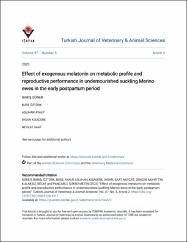| dc.contributor.author | Güner, Barış | |
| dc.contributor.author | Öztürk, Buse | |
| dc.contributor.author | Ayalp, Aslıhan | |
| dc.contributor.author | Kısadere, İhsan | |
| dc.contributor.author | Saat, Nevzat | |
| dc.contributor.author | Zengin, Muhittin | |
| dc.contributor.author | Kulaksız, Recai | |
| dc.date.accessioned | 2024-02-05T15:58:15Z | |
| dc.date.available | 2024-02-05T15:58:15Z | |
| dc.date.issued | 2023 | |
| dc.identifier.issn | 1300-0128 | |
| dc.identifier.issn | 1303-6181 | |
| dc.identifier.uri | https://doi.org/10.55730/1300-0128.4311 | |
| dc.identifier.uri | https://search.trdizin.gov.tr/yayin/detay/1208701 | |
| dc.identifier.uri | https://hdl.handle.net/20.500.12462/13890 | |
| dc.description.abstract | This study aimed to determine whether serum metabolite and hormones of ewes with low body condition scores subjected to the melatonin plus progesterone-based protocol (MPE) would be similar to a single progesterone-based protocol (PE) and whether melatonin ear implant supplementation could increase pregnancy rate. Ninety suckled Merino ewes with singleton lamb were equally allocated in two experimental groups (MPE, PE) and a control group (CON) on days 53 ± 3 (D0) postpartum. Ewes in MPE group were subjected to exogenous melatonin plus progesterone-based protocol [Melatonin (day 0) + P4 insertion (day 35) + 500 IU eCG (day 42)]. Ewes in the PE group were subjected to a progesterone-based protocol [P4 insertion (day 35) + 500 IU eCG (day 42)]. Ewes in the CON group received no application. Blood samples (10 ewes/group) were collected to determine serum leptin, cortisol, insulin-like growth factor 1 (IGF-1), beta-hydroxybutyric acid (BHBA), and prolactin levels on days 0, 35, and 42. A pregnancy diagnosis was performed on days 72 and 102. Neither the synchronisation protocol nor the duration of lactation affected body condition score, (BCS; 2.30 ± 0.05), serum leptin (3.49 ± 0.30 ng/mL), cortisol (6.28 ± 1.10 ng/mL), IGF-1 (53.38 ± 2.09 ng/mL) and BHBA levels (0.24 ± 0.02 mmol/L) at the beginning of study (p > 0.05). However, prolactin levels reduced (p = 0.043) by the time (111.80 ± 12.49, 97.40 ± 3.77, 66.30 ± 4.85 ng/mL) in the MPE group. The oestrus response (p < 0.0001) and pregnancy rate (p = 0.018) were higher in the MPE (70%, 30%) and PE (60%, 30%) groups than in the CON group (10%, 3.3%), respectively. In conclusion, adding a melatonin implant to a progesterone-based protocol decreased prolactin levels but did not change other hormones and BHBA levels. Although both synchronisation protocols increased oestrus response and pregnancy rate, melatonin implant did not contribute to the increment of pregnancy rate compared to a single progesterone-based protocol in suckled Merino ewes with low BCS during the early postpartum period. | en_US |
| dc.language.iso | eng | en_US |
| dc.relation.ispartof | Turkish Journal of Veterinary and Animal Sciences | en_US |
| dc.rights | info:eu-repo/semantics/openAccess | en_US |
| dc.rights | Attribution 4.0 International | * |
| dc.rights.uri | https://creativecommons.org/licenses/by/4.0/ | * |
| dc.subject | Melatonin Implant | en_US |
| dc.subject | Metabolic Profile | en_US |
| dc.subject | Undernutrition | en_US |
| dc.subject | Body Condition Score | en_US |
| dc.subject | Synchronisation | en_US |
| dc.subject | Ewes | en_US |
| dc.title | Effect of exogenous melatonin on metabolic profile and reproductive performance in undernourished suckling Merino ewes in the early postpartum period | en_US |
| dc.type | article | en_US |
| dc.contributor.department | Balıkesir Üniversitesi | en_US |
| dc.identifier.volume | 47 | en_US |
| dc.identifier.issue | 5 | en_US |
| dc.identifier.startpage | 425 | en_US |
| dc.identifier.endpage | 432 | en_US |
| dc.relation.publicationcategory | Makale - Ulusal Hakemli Dergi - Kurum Öğretim Elemanı | en_US |
| dc.buozel | trdizinideal | en_US] |
| dc.department-temp | Balıkesir Üniversitesi, Veteriner Fakültesi, Fizyoloji Anabilim Dalı, Balıkesir, Türkiye Balıkesir Üniversitesi, Veteriner Fakültesi, Hayvan Besleme ve Beslenme Hastalıkları Anabilim Dalı, Balıkesir, Türkiye Balıkesir Üniversitesi, Veteriner Fakültesi, Üreme ve Suni Tohumlama Anabilim Dalı, Balıkesir, Türkiye Balıkesir Üniversitesi, Veteriner Fakültesi, Doğum ve Jinekoloji Anabilim Dalı, Balıkesir, Türkiye Balıkesir Üniversitesi, Veteriner Fakültesi, Doğum ve Jinekoloji Anabilim Dalı, Balıkesir, Türkiye Balıkesir Üniversitesi, Veteriner Fakültesi, Doğum ve Jinekoloji Anabilim Dalı, Balıkesir, Türkiye Balıkesir Üniversitesi, Veteriner Fakültesi, Doğum ve Jinekoloji Anabilim Dalı, Balıkesir, Türkiye Balıkesir Üniversitesi, Veteriner Fakültesi, Doğum ve Jinekoloji Anabilim Dalı, Balıkesir, Türkiye | en_US |
| dc.identifier.trdizinid | 1208701 | en_US |
| dc.identifier.doi | 10.55730/1300-0128.4311 | |



















